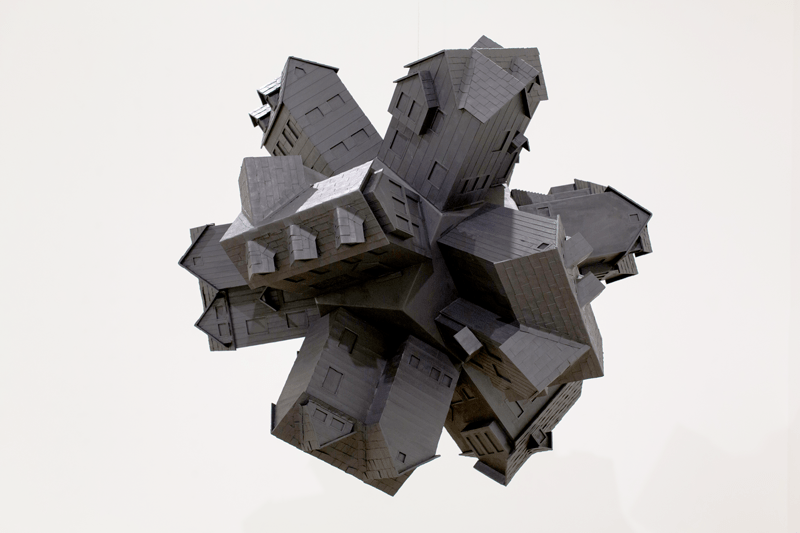In her solo show “Your Words in My Mouth,” Camilla Taylor has created a body of work which, beautiful as it is, aches with bitterness and sorrow. While the sculptural works are ebony, white and gray standouts, the exhibit’s opening salvo includes a series of 10 x 8” dry-point intaglio prints depicting ghostly, empty chairs. Taylor describes these works as “an incomplete statement, each one waiting to make the person into something new for a brief moment.” Certainly, the exhibition itself does that for the individual viewer.
The artist’s dry-point prints also include floating stairs and houses, as the balloon of a house in High Up on the Hill (2020), and images of people such as Joseph (2020), whose magnetic, tormented gaze cuts the viewer to the quick. We are led to recognize ourselves, our lack of self-awareness, and our unwavering wish to avoid spiritual pain.
One to the Other (2019) is one of the show’s centerpieces. It consists of 120 tiny ceramic chairs, not one alike. These perfect and unique inanimate objects seem imbued with a life force, perhaps bestowed upon them by the beings who are not seated in them. They also serve as a link to the almost ephemeral prints. The result is phenomenal: the viewer feels transported into a Lilliputian world, a meeting room where there is no one left to meet; a representation of loss, emptiness, and a longing for something, anything, to fill the seats.

Camilla Taylor, Many Times Over, 2020. Courtesy Track 16 Gallery.
Equally stunning is Many Times Over (2020), a sculptural work consisting of a series of buildings, conjoined into a fascinating dimensional pattern resembling a meteor, a strange star, or a spaceship. It is an image of both destruction and recreation, the reshaping of a conventional structure into an unexpected design, a visual conundrum. It serves well to represent Taylor’s thematic thrust: the comprehension of internal deception. As the exhibition’s gallery notes state, “the lie transformed into truth as the liar now believes it.”
Another show highlight is Speaking in Unison, Telling their Own Lies (2020): 17 glazed ceramic heads, with staring, empty eyes and gaping mouths. Facing inward, linked by string, my first thought was that they were decapitated prizes on the chain of a giant; but they are representative of an interconnectedness through words, or the creation of ourselves through dialogue. In pandemic times, they evoke transmission, whether it is of ideas and conversation or a virus: both spread.
The darkness and varied texture of the works reflect the darkness of our collective nightmares and dreams. This is an exhibition that does two wonderful things simultaneously: creates a visual poetry that requires the viewer to think to decipher, and explores the shattering and glorious dichotomy of the ugliness of lies with the beauty of the forms those lies take.


